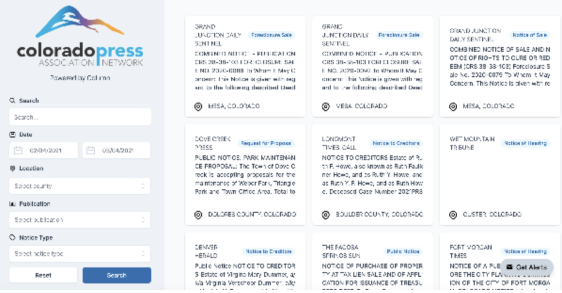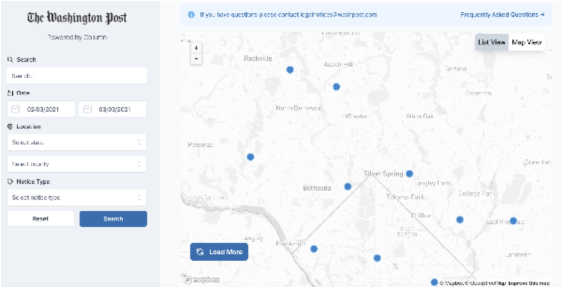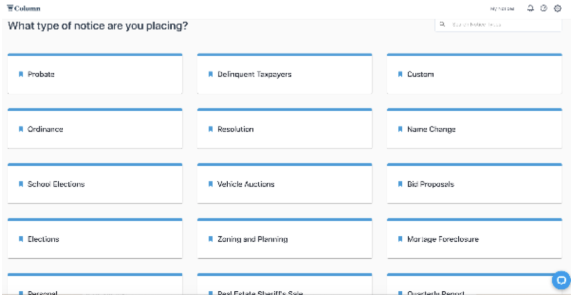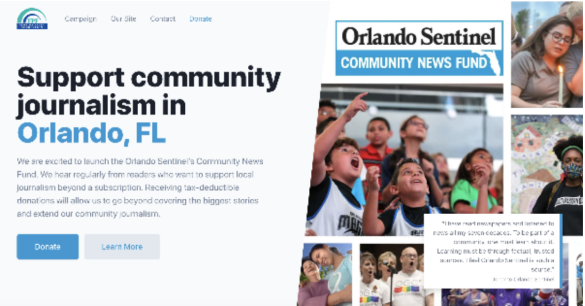
Is This the Future of Public Notices?
Mar. 5, 2021
Hopefully you saw the link in last week’s newsletter about three newspaper chains striking a deal with a company called Column to streamline their public notices.
As the article mentioned, Column has grown significantly in the past year via deals with the Washington Post and numerous state press associations.
By now I hope you know how significant the money generated from public notices is for many newspapers’ bottom lines. And I hope you know about the constant push from lawmakers to end requirements that certain legal notices have to be published in a printed newspaper.
West Virginia Press Association executive director and NewStart founder, Don Smith, is currently in the midst of his yearly battle to save the requirement in his state. And due to a Republican super majority in his state legislature, that battle is quite intense, to say the least.
The alternatives that are proposed by lawmakers are less than ideal. It’s not that they just want to open it up to online publications because that’s where public eyeballs are trending. They want to house these on their own government websites where few people may ever visit, providing less transparency into what is happening in communities across the country.
State press associations have been fighting the good fight for their members, and some, like West Virginia, have created their own websites to help satisfy requirements for a digital presence and improve the experience.
Column is another tool for publishers and state press associations in the battle to keep public notice transparency alive. The company is a public benefit corporation that was started by Jake Seaton, who comes from a long line of newspaper publishers in Kansas.
I got a tour this week of Column and wanted to share some of the details for anyone thinking about upgrading their public notices systems — both individual publishers and press associations.
First of all, let’s start off with the price, because we all know publications are strapped for cash.
It is free for press associations to join the platform, and it is also free for individual publications to use the service. There are no initial costs or maintenance fees.
So ... how does Column make money?
It charges a processing fee on all transactions done via the service. Column suggests passing that on to those placing the ads, so publications do not have to absorb that cost (credit card fees are baked into that processing fee, BTW).
What does it look like? Here’s an example of how the Colorado Press Association uses Column for public notices.

The statewide database is searchable via date, location, publication and notice type. Users also can sign up to get email alerts based off of search queries daily, weekly or monthly.
Individual publishers can have a similar look. The Washington Post went as far as to add a mapping feature, allowing people to locate trustee sales, for example, across the D.C. region.

Column can also help publishers manage their notices and streamline the process.
There is a self-service option for those placing ads. Column can help create custom affidavit templates for the public to use, provide rates and show a preview of how it will look in print. It can even help paginate notices as they come through the system.

I could see Column creating some additional tools down the road so publishers could insert legal notices into their existing editorial newsletters, or exporting the data in a format that investigative reporters could use to find story ideas or track trends over time.
Joey Young, majority owner of Kansas Publishing Ventures, said his company has enjoyed its experience with Column so far.
“We have had very little trouble with clients adapting to it, and when we have had issues the Column staff have been super easy to work with in getting those issues fixed,” he said via email. “We have most of our customers converted to using Column, as we took a slow and steady uploading process approach. Our hope is to get to about 90 percent adoption for our three legal newspapers.”
There is one other Column feature to note — a donation platform.
Column offers a set of out-of-the-box donation tools that the foundation arm of an association can use to send donations to newspapers. Column can help foundations customize the page, keep track of donations and email receipts to donors.
Here are a few examples from the New York Newspaper Foundation and the Florida Press Foundation.

The Orlando Sentinel is one newspaper that has benefited from this arrangement. You can read about the publication's efforts here.
As long as newspapers still have public notices, they will have to find a good way to make the entire process of acquiring and publishing them happen with as few pain points as possible. In general, turning over valuable content to a third party is a risky proposition, but if your newspaper or association can't do it alone, Column may be a good option. The terms seem to be solid (for now). And hopefully efforts like this will help in the battle to ensure that government agencies continue to be transparent for years to come.
